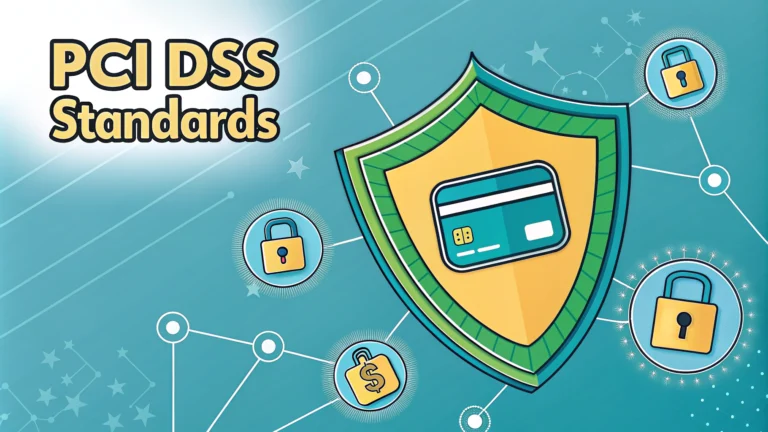PCI DSS penetration testing helps organizations identify and fix security weaknesses before attackers can exploit them.
Regular penetration testing is a requirement for PCI DSS compliance, specifically outlined in requirement 11.3 of the standard.
This guide explains the key requirements, best practices, and steps for conducting effective PCI DSS penetration tests.
Core PCI DSS Penetration Testing Requirements
- Annual testing of both internal and external networks
- Additional testing after significant infrastructure changes
- Testing must follow industry-accepted approaches like NIST
- Documentation of testing methodology and results
- Remediation of identified vulnerabilities
Types of Required Testing
External penetration testing examines networks and systems from outside the cardholder data environment.
Internal testing evaluates security controls from within the organization’s network.
| Test Type | Focus Areas |
|---|---|
| Network Layer | Firewalls, routers, switches |
| Application Layer | Web apps, payment portals, APIs |
| Security Controls | Authentication, encryption, access controls |
Testing Methodology
- Planning and Scope Definition
- Identify systems storing card data
- Document network boundaries
- Define testing objectives
- Vulnerability Assessment
- Scan for known vulnerabilities
- Review system configurations
- Identify potential weak points
- Active Testing
- Attempt authorized system breaches
- Test security control effectiveness
- Document successful exploits
Common Testing Tools
- Nmap – Network mapping and port scanning
- Metasploit – Exploitation framework
- Burp Suite – Web application testing
- Wireshark – Network traffic analysis
- OWASP ZAP – Web security testing
Documentation Requirements
Test reports must include detailed findings, methodology, and remediation recommendations.
- Testing scope and objectives
- Tools and techniques used
- Discovered vulnerabilities
- Risk ratings for findings
- Recommended fixes
- Retest results after fixes
Taking Action on Results
- Prioritize fixes based on risk levels
- Create detailed remediation plans
- Document all changes made
- Perform validation testing
- Update security policies
Building Your Security Strategy
Contact qualified security assessors (QSAs) to help develop your penetration testing program – find a list at PCI Security Standards Council.
Consider automated testing tools to supplement manual testing efforts.
Implement continuous monitoring between annual tests to maintain security posture.
Ongoing Monitoring Best Practices
- Deploy intrusion detection systems (IDS)
- Implement log monitoring solutions
- Conduct regular vulnerability scans
- Review security alerts daily
- Track system changes
Testing Frequency Considerations
While annual testing is the minimum requirement, organizations should consider more frequent testing based on:
- Rate of system changes
- Business risk profile
- Previous test findings
- Industry threat landscape
Common Testing Challenges
Technical Challenges
- Complex network architectures
- Cloud environments
- Third-party integrations
- Legacy systems
Organizational Challenges
- Resource constraints
- Business disruption concerns
- Scheduling limitations
- Stakeholder coordination
Strengthening Your Security Posture
Effective PCI DSS penetration testing requires a comprehensive approach combining:
- Regular assessment schedules
- Robust testing methodologies
- Clear documentation practices
- Swift remediation processes
- Continuous monitoring systems
Organizations should view penetration testing not just as a compliance requirement, but as a crucial component of their overall security strategy to protect sensitive payment card data.
FAQs
- What is PCI DSS penetration testing and why is it required?
PCI DSS penetration testing is a required security assessment that evaluates the network security of cardholder data environments through controlled cyberattack simulations. It’s mandated by PCI DSS Requirement 11.3 to identify security weaknesses that could expose payment card data. - How often must PCI DSS penetration testing be performed?
PCI DSS penetration testing must be performed at least annually and after any significant infrastructure or application changes to systems within the cardholder data environment. - What are the different types of PCI DSS penetration testing required?
PCI DSS requires both internal and external network penetration testing, segmentation testing (if used), and testing of both application and network layers that could affect the security of cardholder data. - Who can perform PCI DSS penetration testing?
Testing must be performed by qualified internal resources or qualified external third parties who are organizationally independent and have specialized penetration testing expertise. They must follow industry-accepted penetration testing approaches. - What must be included in the scope of PCI DSS penetration testing?
Testing must cover the entire cardholder data environment perimeter, critical systems, and all systems that could affect the security of cardholder data, including both network-layer and application-layer testing. - What methodology must be followed for PCI DSS penetration testing?
Testing must follow industry-accepted approaches like NIST SP 800-115, OSSTMM, or PTES, and include validation of any segmentation controls, threat modeling, and network-layer and application-layer testing. - What documentation is required for PCI DSS penetration testing?
Organizations must maintain documented penetration testing procedures, results of testing, remediation activities, and follow-up testing to verify that identified vulnerabilities have been addressed. - What happens if vulnerabilities are found during PCI DSS penetration testing?
All high-risk vulnerabilities identified must be remediated and retested to verify the fixes. Organizations must follow a risk-based approach to address medium and low-risk vulnerabilities according to their risk management process. - How does PCI DSS penetration testing differ from vulnerability scanning?
Penetration testing involves active exploitation of security weaknesses and requires manual testing by qualified professionals, while vulnerability scanning is automated testing that identifies known vulnerabilities without exploitation. - What are the consequences of failing to perform required PCI DSS penetration testing?
Failure to perform required penetration testing can result in non-compliance with PCI DSS, potential fines, increased transaction fees, loss of ability to process credit cards, and increased risk of data breaches.







